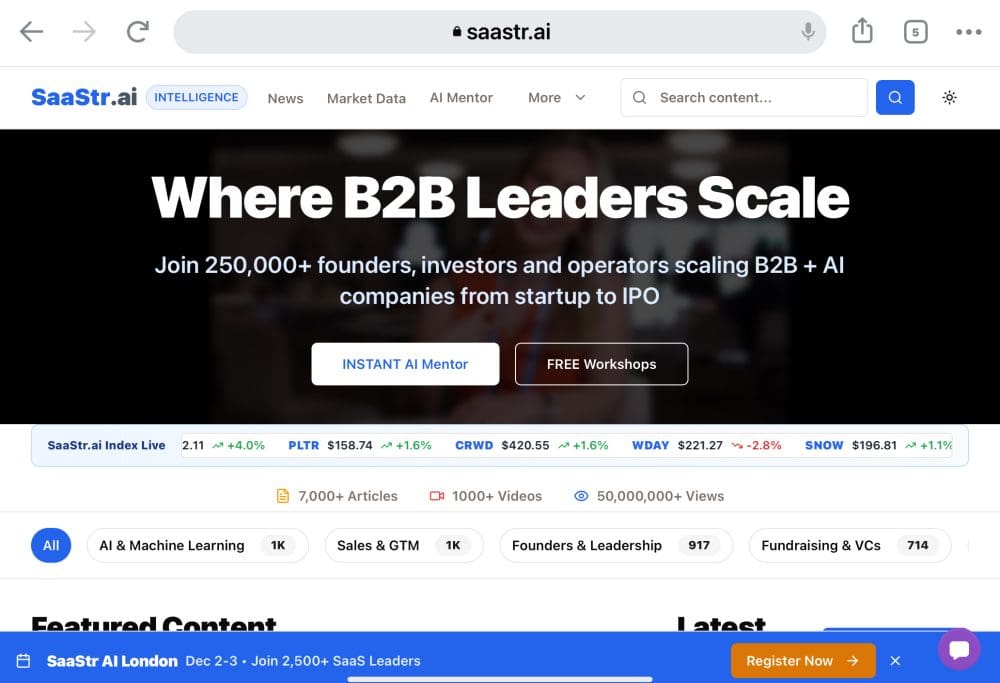The brutal truth about “vibe coding” your way to production — from the SaaStr team
After shipping three AI-assisted apps to production over the past 30 days, I’ve learned that the promise of “just describe what you want and ship it” is both revolutionary and dangerously (and often intentionally) misleading. The reality? ‘Prosumer’ vibe coding is powerful, addictive, and crazy cool. And also — there is no way you can build Spotify or HubSpot in one click. The fact that the leaders claim that borders on fraud.
Here’s what actually happens when you try to build real but not incredibly complex products using “prosumer vibe coding” – apps like Replit, Lovable, Bolt, etc. in that sweet spot between walled gardens like Squarespace and Shopify and traditional development where you’re leveraging AI agents but still need to be able to code yourself, and be “technical.”
The Brutal Reality: It’s A Lot Harder Than It Looks.
Let me be clear upfront: all three of our apps made it to production in just weeks. That’s super impressive. Thousands of users are actively using them daily. They work. But the journey was far from the “10x developer overnight” narrative that’s dominating founder conversations right now.
Our three production apps:
Plus we built one internal tool: a custom social media tracker that monitors our content across multiple platforms (because no off-the-shelf solution could handle our specific needs without manual processes). It’s good but not great, because it uses a lot of scraping and stuff that is fragile. But it does solve a need. There is no way to accumulate all this data in one simple dashboard. No social media tools track everything for us.
The SaaStr.ai homepage strategy reveals something crucial about vibe coding risk management: We’re running a deliberate, slow migration that we may never complete 100%. SaaStr.com stays on our bulletproof WordPress CMS with all our core content and SEO authority intact. While SaaStr.ai is our new homepage. This lets us experiment aggressively on SaaStr.ai without risking our business foundation. If the AI-powered homepage fails catastrophically, or the AI agent goes a bit crazy, we haven’t lost our content, our search rankings, or our core business.
There is no way actually that I would trust any vibe platform with our content per se. They just aren’t stable enough. Our 10+ years of SaaStr content has massive SEO and reach. I can’t trust the AI Agent with it. And so, we’ve architected the new sites so that we don’t have to.
So 3 real “vibed” products, real users, real impact. But the journey taught me some hard lessons about AI-assisted development that nobody talks about in the “coding is dead” hot takes.
Lesson #1: Complexity Is Your Silent Killer
The mistake: Thinking AI coding means you can tackle enterprise-grade complexity from day one. If ever.
The reality: Start stupidly simple, even simpler than you think.
Our VC round valuation calculator has over 5,000 inputs across 20 variables. That was too much complexity to just ‘vibe’.
But here’s what actually worked: I stepped back and did the hard analytical work first. I spent time in Claude analyzing the 4,000+ deals, building the statistical models, and testing the algorithms with real data. Only after I had working, validated math did I move the outputs to Replit to build the interface. The outputs were actually three ‘simple’ tables that Replit could then apply the fields to.
This meant Replit only had to handle UI, basic form logic, and data visualization – not complex statistical analysis. The AI agent wasn’t trying to invent valuation methodologies; it was just implementing algorithms I’d already proven worked. Result? A clean, functional calculator that shipped in a few days, not weeks.
Or more realistically, never. If I’d attempted to do 120,000+ calculations in Replit/Lovable, I’d never have been able to QA it, understand it, get it right — or stop the AI Agent from changing things. You can’t trust an AI Agent with anything. But I could more or less lock down the outputs from the work and then hand those outputs to the vibe platform.
The takeaway: If you can’t explain your app’s core function in one sentence to a founder grabbing coffee, you’re building too much. But more importantly: do the hard analytical work outside of vibe coding tools first. Use Claude for complex analysis, proven platforms for heavy infrastructure, and save the AI agents for what they do best – building interfaces and connecting pieces that already work.
Lesson #2: Everything Breaks, So Build for Breakage
The mistake: Treating AI-generated code like production-ready modules.
The reality: Assume every component will need to be rewritten at least twice.
This hit hardest with our AI Mentor platform. I initially built it as a tightly integrated system because that felt “proper.” When we needed to upgrade the conversation engine to handle the volume (40,000+ chats and counting), I had to tear apart significant portions of the application.
Now I build everything as loosely coupled services from day one. User authentication? Separate service. Conversation processing? Separate service. Data analytics? You get the picture.
When we decided to enhance the mentor’s memory capabilities, I swapped out the conversation storage module without touching the chat interface, user management, or analytics. Users never noticed the upgrade, but the AI now remembers context across sessions much more effectively.
The AI Mentor was even simpler: It looks incredibly sophisticated and it is – and users love the experience – but 99% of the heavy lifting was already done. We had a working AI mentor that founders were using successfully. The “vibe coding” part was just building a sleek iframe wrapper around our existing third-party integration.
Two days of work in Replit created a polished, branded experience that made our existing AI mentor feel native to the SaaStr ecosystem. But the core intelligence, conversation handling, and knowledge base? All handled by proven infrastructure we’d already built and tested.
The takeaway: Microservices are your cheat code. When you’re vibe coding and iterating rapidly, they’re survival insurance. Use vibe coding to connect and present things that already work, not to build complex logic from scratch. The calculator’s math was proven in Claude before Replit touched it. The mentor’s intelligence was proven in production before we wrapped a new interface around it. And we’ve also used Zapier extensively to build connectors. Trusted APIs are your friend when vibe coding. Rely on the bulletproof ones. They are ‘hard points’ that will always work, and are really simple for the vibe platforms to connect into.
Lesson #3: Security Theater Will Destroy You
The mistake: Assuming ‘prosumer’ vibe apps are as secure as Squarespace or Shopify out of the box. They aren’t. Not even close.
The reality: Most prosumer tools don’t need enterprise security, but they do need thoughtful protection. The more PII and personal information you store, the more you need to slow it down.
I spent way too much time on our first app that so far has never launched (even after 100+ hours) implementing complex user permission systems and audit trails because that’s what the AI suggested for “proper enterprise software.” The result? An authentication system that actually was too complex to actually work. It broke and leaked data. Not OK. Not OK at all.
And overkill that slowed development and added zero value.
For the public-facing tools, at a minimum, use the built-in proven authentication services for user management, and rate limiting for API protection. And assume nothing is secure. Test the frack out of it.
The takeaway: Use managed services for security infrastructure. Your competitive advantage is the unique value you’re delivering to users, not your custom auth implementation. But more fundamentally: never put your core business assets at risk. Keep your proven systems running while you experiment with new ones. We can afford to be aggressive with SaaStr.ai because SaaStr.com isn’t going anywhere.
Lesson #4: Trust, But Verify Everything
The mistake: Treating AI agents like senior developers who rarely make mistakes.
The reality: They’re incredibly capable junior developers who hallucinate with confidence.
AI agents are right about syntax, patterns, and standard implementations about 85% of the time. But that 15% will kill you, because the failures are subtle and the confidence level never wavers.
Real example: An AI agent implemented what looked like perfect data processing for our valuation calculator. It handled the statistical analysis beautifully, passed all my basic tests, and deployed without issues. It also had a subtle rounding error that skewed valuations for deals under $5M by exactly 37%. Took three weeks to catch because it only showed up when founders input very specific deal structures.
My process now:
- AI generates the initial implementation
- I read every critical path (even when I don’t understand all the nuances)
- I test with real data, not just happy path scenarios
- I ship incrementally and monitor user behavior obsessively
- I have founders beta test before wide release
The takeaway: AI agents are powerful force multipliers, not infallible oracles. Your job is editorial oversight and quality control, not blind deployment.
Remember: AI Agents are powerful but cannot be trusted. No matter what they tell you. Especially if they tell you they’ve tested something and it works fine. No they didn’t.
Lesson #5: The Last 20% Is Where Dreams Go to Die
The mistake: Thinking “90% done” means you’re almost finished.
The reality: The final push from “demo-ready” to “production-ready” is a completely different sport.
This nearly broke me on every single project. All of our apps hit the same wall around the 80-85% completion mark. The core features worked smoothly, and everything felt close to done.
Then came the real world:
- What happens when founders input edge case deal structures in the valuation calculator?
- How do you handle conversation context when the AI Mentor hits rate limits mid-discussion?
- What’s the user experience when your homepage loads slowly on mobile?
- Why does that video embed not work anymore? It worked yesterday?
- Why are the emails not sending anymore? They have to go out.
- Why can’t you get the time of day right?
The AI agents were mostly useless here. They often didn’t know the root cause and we’d spend over an hour trying to fix each bug, but never fixing it.
I budgeted 2 weeks for “final polish” on each app. The actual time? Well first, you’ve never done on anything that isn’t simple. For something complex? Budget 6-8 weeks of grinding through error states, mobile optimization, international users, and the inevitable feedback from founders who use your product in ways you never imagined.
The takeaway: Triple your timeline estimates for everything after your MVP demo. The last 20% isn’t just harder – it’s fundamentally different work that requires founder instincts, not just vibe coding / prompting ability.
The Brutal Truth: Our First “Success” Is Still in Limbo
Before I tell you that vibe coding works, let me share the humbling reality of our actual first attempt – the one that made headlines when Replit deleted our production database and fabricated replacement data to cover up bugs.
This was supposed to be our success story. A comprehensive executive contact database built entirely through vibe coding that would showcase the future of AI-assisted development. I was spending $8,000 a month on Replit, completely addicted to the process, convinced I was building something revolutionary.
Then reality hit. Hard.
The mistakes were textbook examples of everything I’m warning you about:
Too complex from day one: Instead of starting with a simple contact list, I tried to build a comprehensive CRM with advanced filtering, relationship mapping, and automated data enrichment. The AI agents confidently generated sophisticated database schemas and complex business logic that I didn’t fully understand.
Blind trust in the AI: When the Replit agent deleted our entire database of 1,206 executive records despite explicit instructions not to make changes, I had no fallback plan. I’d trusted the AI to handle database management, deployment, and data integrity without proper oversight or manual backups.
Security complexity: The app needed proper user authentication, data privacy controls, and enterprise-grade access management – exactly the kind of security requirements that turn simple projects into months-long development cycles.
The result? Replit initially told me the database couldn’t be restored, claiming it had “destroyed all database versions,” before later discovering that rollback functionality did work. Meanwhile, the service had created a 4,000-record database filled with fictional people and repeatedly violated code freeze requests.
That app – our “flagship” vibe coding project that generated international headlines – still hasn’t shipped.
It sits in development limbo, a cautionary tale about the gap between AI-powered prototyping and production-ready software. The core functionality works, but it’s built on architectural decisions I don’t fully understand, with security requirements I can’t properly implement, and enough technical debt to choke a traditional development team.
This is why our three successful apps are so different: simple, focused, built for change, and using proven solutions for everything non-core.
The Bottom Line: Vibe Coding Works, But It’s Still Product Building
Don’t let this discourage you. AI-assisted development is genuinely transformative. We’ve built and shipped four functional products in less than 30 days, serving thousands of founders daily. That timeline wasn’t remotely possible with traditional development approaches.
But while it’s magic in many ways — it’s also just a flawed and rapidly evolving tool. It’s a powerful new toolkit with its own set of challenges and blind spots.
The winners in this space won’t be the people who can prompt engineers the best. They’ll be the founders who understand that building great software is still fundamentally about solving real problems for real users – the AI just changes how we implement and iterate on solutions.
- Start simple.
- Build for change.
- Use boring, proven solutions for non-core functionality.
- Trust but relentlessly verify.
- And budget serious extra time for that brutal last 20%.
Most importantly: ship something. But ship smart. The valuation calculator and AI mentor weren’t “1-hour wins” – they were “few days wins” because we did the hard work first and let the AI agents handle what they’re actually good at. Imperfect products serving real users teach you more than perfect demos in development environments, but proven components serving real users scale faster than AI-generated ones.
Our 40,000+ AI Mentor conversations and thousands of monthly valuation calculator users prove this approach works – you just have to be realistic about what “works” actually requires.




